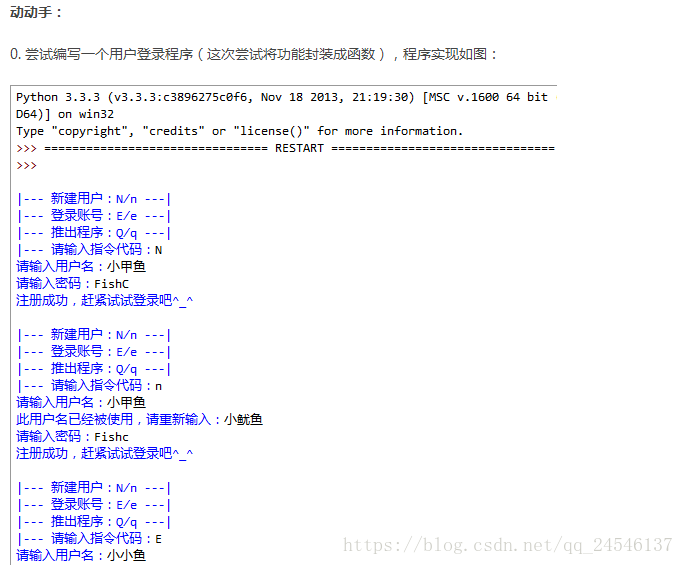小甲鱼《零基础学习Python》课后笔记(二十六):字典——当索引不好用时2
测试题
0.Python的字典是否支持一键(Key)多值(Value)?
不支持。对相同的键赋值会覆盖原来的值。
>>> dict2 = {1:'one',1:'two',3:'three'}
>>> dict2
{1: 'two', 3: 'three'}
1.在字典中,如果试图为一个不存在的键(Key)赋值会怎样?
会创建一个新的键值对。
>>> dict1 = {1:'one',2:'two',3:'three'}
>>> dict1
{1: 'one', 2: 'two', 3: 'three'}
>>> dict1[4] = ('four')
>>> dict1
{1: 'one', 2: 'two', 3: 'three', 4: 'four'}
2.成员资格符(in和not in)可以检测一个元素是否在序列中,当然也可以用来检查一个键(Key)是否在字典中。那么请问哪种的检查效率更高些?为什么?
字典的效率要更高一些。因为字典的原理是使用哈希算法存储,不需要使用查找算法进行匹配,时间复杂度是O(1)。
3.Python对键(Key)和值(Value)有没有类型限制?
Python对键有要求,要求是可哈希(Hash)的对象,不能是可变类型(包括变量,列表,字典本身等)
对于值就没有任何限制,可以是Python里的任何类型。
4.请目测下边代码执行后,字典dict1的内容是什么?
dict1.fromkeys((1,2,3),('one', 'two', 'three'))
dict1.fromkeys((1,3), '数字')
dict1的内容不变,保持原来的内容。
>>> dict1 = {}
>>> dict1.fromkeys((1,2,3),('one', 'two', 'three'))
{1: ('one', 'two', 'three'), 2: ('one', 'two', 'three'), 3: ('one', 'two', 'three')}
>>> dict1.fromkeys((1,3), '数字')
{1: '数字', 3: '数字'}
>>> dict1
{}
要注意fromkeys()方法是返回一个新创建的字典。
>>> dict2 = dict1.fromkeys((1,2,3),('one', 'two', 'three'))
>>> dict2
{1: ('one', 'two', 'three'), 2: ('one', 'two', 'three'), 3: ('one', 'two', 'three')}
>>> dict2 = dict1.fromkeys((1,3), '数字')
>>> dict2
{1: '数字', 3: '数字'}
>>> dict1
{}
>>> dict1 = {1:'one',2: 'two',3: 'three'}
>>> dict2 = dict1.copy()
>>> dict3 = dict1
>>> dict1
{1: 'one', 2: 'two', 3: 'three'}
>>> dict2
{1: 'one', 2: 'two', 3: 'three'}
>>> dict3
{1: 'one', 2: 'two', 3: 'three'}
>>> dict3[4] = 'four'
>>> dict1
{1: 'one', 2: 'two', 3: 'three', 4: 'four'}
>>> dict2
{1: 'one', 2: 'two', 3: 'three'}
>>> dict3
{1: 'one', 2: 'two', 3: 'three', 4: 'four'}
>>> dict2[4] = 'five'
>>> dict1
{1: 'one', 2: 'two', 3: 'three', 4: 'four'}
>>> dict2
{1: 'one', 2: 'two', 3: 'three', 4: 'five'}
>>> dict3
{1: 'one', 2: 'two', 3: 'three', 4: 'four'}
赋值等号是把一个字典指向内存地址而已,所以改变dict3也就是操作和dict1一样的内存。
动动手
0.尝试编写一个用户登录程序(这次尝试将功能封装成函数),程序实现如图:


def Log_On():
'用户登录程序'
dict1 = {}
while True:
print('|---新建用户:N/n---|')
print('|---登录账号:E/e---|')
print('|---推出程序:Q/q---|')
number =input('|---请输入指令代码:')
if (number == 'N') or (number == 'n'):
key = input('请输入用户名:')
for x in range(4):
if key in dict1:
key = input('此用户名已被使用,请重新输入:')
value = input('请输入密码:')
dict1[key] = value
print('注册成功,赶紧试试登录吧^_^')
break
else:
value = input('请输入密码:', )
dict1[key] = value
print('注册成功,赶紧试试登录吧^_^')
break
continue
elif (number == 'E') or (number == 'e'):
key = input('请输入用户名:')
if key in dict1:
for x in range(3):
value = input('请输入密码:')
if dict1[key] == value:
print('欢迎进入WOLF系统,点击右上角的X结束程序!')
break
else:
if x < 2:
print('出错提示:密码错误,请您重新登录!')
continue
else:
break
continue
else:
for x in range(3):
key = input('你输入的用户名不存在,请重新输入:')
if key in dict1:
value = input('请输入密码:')
print('欢迎进入WOLF系统,点击右上角的X结束程序!')
break
else:
if x < 2:
print('不存在此用户名,请检查书写,重新输入:')
continue
continue
elif (number == 'Q') or (number == 'q'):
break
else:
print('输入错误!')
continue
Log_On()